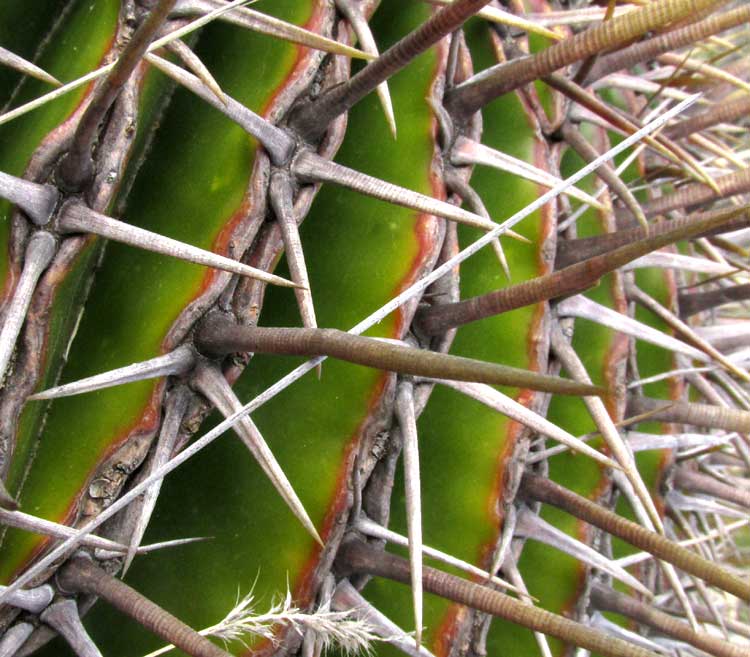Excerpts from Jim Conrad's
Naturalist Newsletter
from the May 10, 2018 Newsletter with notes from a camping trip in Coahuila state, MÉXICO
GIANT BARREL CACTUS
During my recent camping trip in the highlands east of Saltillo, Coahuila, on April 5th I started out hiking on a valley floor, and climbed a small mountain that was grassy and scrubby at its base, but forested on top. Toward the top, at ±7000 feet in elevation (2100m), where trees were just starting to appear, I found the handsome barrel cactus shown below:

Among features important for identification purposes we can see that this is a large, ±spherical cactus, with spines arising in clusters from atop conspicuous vertical ridges pleating the cactus's body. Below, clusters of spines are shown close up:

Notice that the clusters arise from spots known as areoles. In the picture, five spines arise from each areole. The fifth spine may escape you at first, for it's smaller and much slenderer than the others; it arises at the base of the largest, thickest spine, and points upward.
This cactus belongs to a large group commonly known as barrel cacti, and several barrel cactus species display features more or less like these. The field mark on the one in the photo distinguishing it from most other species is that large tuft of golden-white items at the cactus's very top, a close-up shown below:

You can guess that those are old flowers, the corollas drying up and turning brown as the ovaries beneath them swell into fruits. I'd assumed that such flowering/fruiting remnants would remain on the cactus body for only a brief time during its yearly life cycle, which is what I've experienced with most other cactus species. However, on the Internet and in books, most images I find of the species show such tufts, so they must be long enduring and and somewhat distinctive for the species.
Happily the excellent, well illustrated, Spanish-language Guía de Cactáceas del Estado de Coahuila by Alfredo Flores {was} freely available on the Internet.
In that fine work I learn that our cactus is ECHINOCACTUS PLATYACANTHUS. In English it's known as the Giant Barrel Cactus, though other species may share that name. Echinocactus platyacanthus is endemic to the Chihuahuan Desert part of central Mexico, where often it occurs in abundance. It can grow up to seven feet tall (2m), and individuals over 400 years old have been encountered.
This cactus is much appreciated for its size and ornamental qualities, for which reason it's suffered from collectors. Even more threatening to its numbers are forest fires and livestock grazing. In Mexico the species is considered as vulnerable.